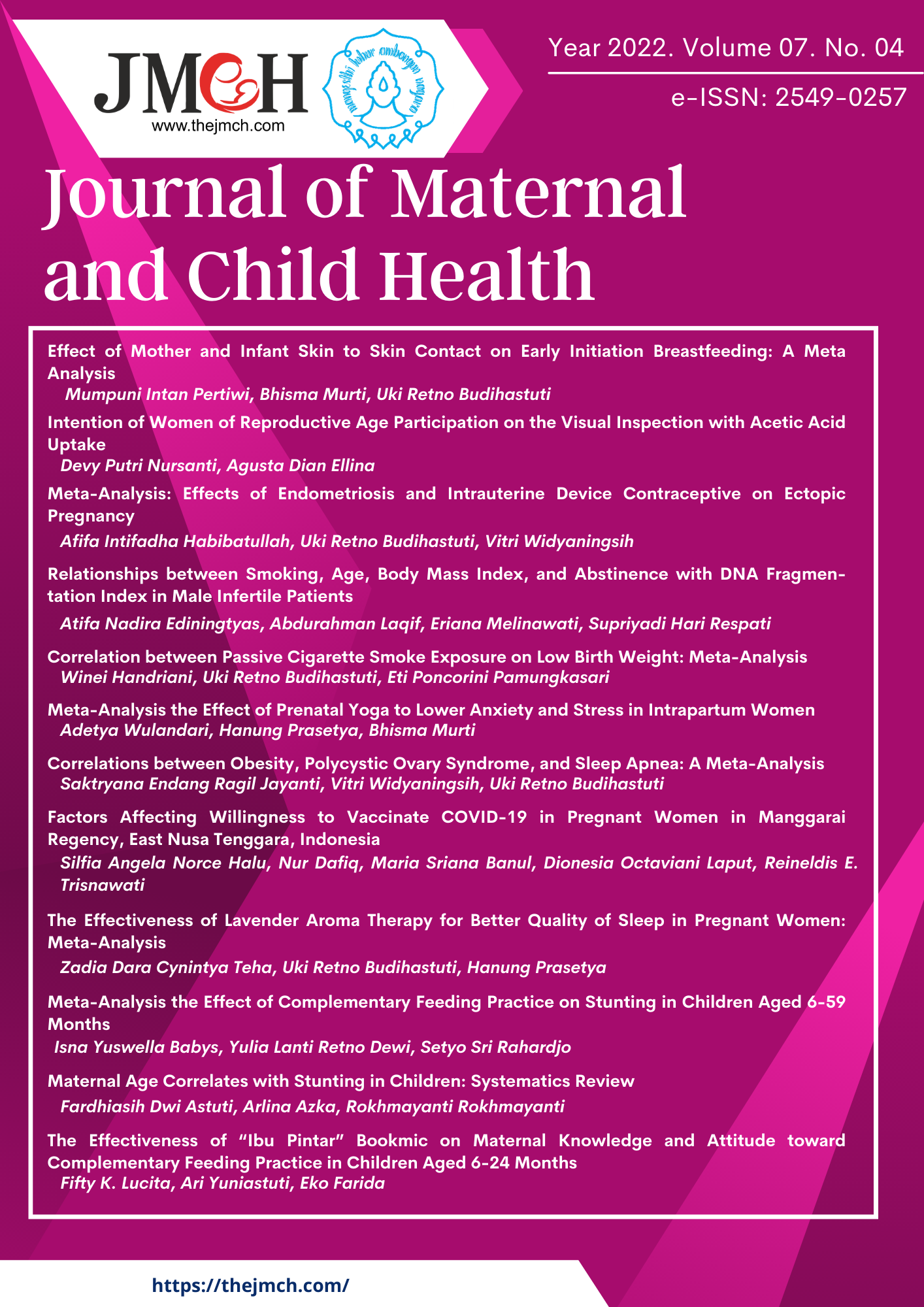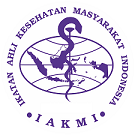Correlations between Obesity, Polycystic Ovary Syndrome, and Sleep Apnea: A Meta-Analysis
DOI:
https://doi.org/10.26911/thejmch.2022.07.04.07Abstract
Background: Obesity is one of the biggest public health problems in the world. Obesity is associated with various health problems, decreased quality of life and death. Obesity is known to have an impact on women's lives, namely Polycystic Ovary Syndrome (PCOS) which if not treated immediately can cause sleep apnea. This study aims to analyze the relationship between obesity and PCOS and sleep apnea.
Subjects and Method: This research is a systematic review and meta-analysis. Population = women, Intervention = obesity, Comparison = not obese, Outcomes = PCOS and sleep apnea. Article searches through journal databases include: PubMed, Science Direct, Google Scholar, and Springerlink. The keywords used are obesity OR obese AND PCOS OR “Polycystic Ovary Syn- drome” AND “sleep apnea” OR “Poor Sleep” OR “obstructive sleep apnea”. Articles were selected with the help of PRISMA flow diagrams. Inclusion criteria include full-text articles with obser- vational studies, multivariate analysis results in the form of aOR values and published from 2012- 2021. Eligible articles were analyzed using the Revman 5.3 application.
Results: Eighteen articles from the United States, Brazil, China, Turkey, Iraq, Pakistan, Sri Lanka, Korea, West Africa, East Africa, Nigeria and the United Kingdom were included in the meta- analysis. A meta-analysis of the results of the case-control study design subgroup (4 articles) and the cross-sectional study (4 articles) showed that obese women had a 1.14-fold increased risk of developing PCOS compared to non-obese women (aOR = 1.14; 95% CI = 1.03 to 1.26; p= 0.010). A meta-analysis of 10 cross-sectional studies showed that obese women increased the risk of developing sleep apnea 4.66 times than non-obese women (aOR = 4.66; 95% CI = 3.23 to 6.71; p =
<0.001).
Conclusion: Obesity is a risk factor for PCOS (Polycystic Ovary Syndrome) and sleep apnea in women.
Keywords: obesity, PCOS, sleep apnea, meta-analysis.
Correspondence: Saktryana Endang Ragil Jayanti. Master’s Program in Public Health, Universitas Sebelas Maret, Jl. Ir. Sutami 36A, Surakarta 57126, Central Java, Indonesia. Email: Saktryana.agil@gmail.com. Mobile: 082242154117.
Keywords:
obesity, PCOS, sleep apnea, meta-analysisReferences
Anisya V, Rodiani, Graharti R (2019). Risiko infertilitas yang dapat dicegah melalui penurunan berat badan pada wanita obesitas policystic ovary syndrome (Risk of infertility that can be prevented through weight loss in obese women). Fakultas Kedokteran, Universitas Lampung, 9, 267–275. Retrieved from: http://juke.kedokteran.unila.ac.id/index.php/medula/art icle/view/2380
Antonaglia C, Passuti G (2014). Sleep and breathing sleep breathing physiology and disorders review obstructive sleep apnea syndrome in non-obese patients. Sleep and Breathing, 1, 3. https://doi.org/10.1007/s11325021024121
Awopeju OF, Fawale MB, Anu S, Salami OT, Adewole OO (2020). The risk of obstructive sleep apnea and its association with indices of general and abdominal obesity in a Nigerian family practice clinic : a cross-sectional study. Alex J Med, 56(1): 14–20. https://doi.org/10.1080/20905068.2 019.1711304
Barasi M (2009). At a Glance ilmu gizi. Erlangga. Jakarta.
Barber TM, Hanson P, Weickert MO, Franks S (2019). Obesity and polycystic ovary syndrome: implications for pathogenesis and novel management strategies. Clin. med. insight: Reprod. Health, 13, 117955811987404. https://doi.org/10.1177/1179558119874042
Barros de Carvalho MM, Quental Coutinho R, Barros IML, Costa F, Medeiros AKL, Lustosa TC, Medeiros CA, et al. (2018). Prevalence of obstructive sleep apnea and obesity among middle-aged women: Implications for exercise capacity. J Clin Sleep Med, 14(9): 1471–1475. https://doi.org/10.5664/jcsm.7316.
Bedrick BS, Eskew AM, Chavarro JE, Jungheim ES (2020). Self-administered questionnaire to screen for polycystic ovarian syndrome. Women’s Health Rep, 1(1): 566–573. https://doi.org/10.1089/whr.2020.0073
Branavan U, Wijesundera S, Chandrasekaran V, Arambepola C, Wijeyaratne C (2020). In depth analysis of the association of FTO SNP (rs9939609) with the expression of classical phenotype of PCOS: a Sri Lankan study. BMC Med. Genetics, https://doi.org/10.1186/s1288102009611
Chen X, Pensuksan W C, Lertmeharit S, Gelaye B (2014). Obstructive sleep apnea and multiple anthropometric indices of general obesity and abdominal obesity among young adults. NIH Public Access. https://doi.org/10.11114/ijsss.v2i3.439
Ding W, Zhang F, Liu X, Hu L, Dai S, Li G, Kong H, Guo Y (2019). Impact of female obesity on cumulative live birth rates in the first complete ovarian stimulation cycle. Frontiers in Endocrinol, 10(August), 1–7. https://doi.org/10.3389/fendo.2019.00516
Downey (2012). Obstructive sleep apnea. Medscape Drugs Diseases and Procedures. https://emedicine.medscape.com/article/295807overview#a3
El Hayek S, Bitar L, Hamdar L H, Mirza FG, Daoud G (2016). Polycystic ovarian syndrome: an updated overview. Front. in Physiology, 7(APR), 1–15. https://doi.org/10.3389/fphys.2016.0 0124.
Esmaeilzadeh S, Andarieh hanbar, Ghadimi R, Delavar MA Gajan (2015). Body mass index and gonadotropin hormones (LH dan FSH) associate with clinical symptoms among women with polycystic ovary syndrome. Global J. of Health Sci, 7(2): 101–106. https://doi.org/10.5539/GJHS.V7N2P101
Ferreira RC, Halpern G, Figueira S, Braga
F, Iaconelli A, Borges E (2010). Physical activity, obesity and eating habits can influence assisted reproduction outcomes. Women’s Health, 6(4): 517–524. https://doi.org/10.2217/whe.10.40
Greenwood EA, Pasch LA, Cedars MI, Huddleston HG. (2020). Obesity and depression are risk factors for future eating disorder-related attitudes and behaviors in women with polycystic ovary syndrome. Fertility and Sterility, 113(5): 1039–1049. https://doi.org/10.1016/j.fertnstert.2020.01.016
Hachul H, Polesel DN, Tock L, Carneiro G, Pereira AZ, Zanella MT, Tufik S, Togeiro SM (2019). Sleep disorders in polycystic ovary syndrome: influence of obesity and hyperandrogenism. rev assoc med. bras, 65(3): 375–383. https://doi.org/10.1590/18069282.65.3.375
Jamil AS, Alalaf SK, Al-Tawil NG, Al-Shawaf T (2015). A case-control observational study of insulin resistance and metabolic syndrome among the four phenotypes of polycystic ovary syndrome based on Rotterdam criteria Female Fertility. Rep Health, 12 (1): 1–9. https://doi.org/10.1186/17424755127
Kim J, Lee SY (2017). Obesity indices related to obstructive sleep apnea in obese adults. J Biosciences Med, 05(10): 34–43. https://doi.org/10.4236/jbm.2017.510004
Kogure GS, Ribeiro VB, Lopes IP, Furtado M, Kodato S, Silva de Sa MF, Ferriani RA, Lara da S, Maria dos Reis R (2019). Body image and its relationships with sexual functioning, anxiety, and depression in women with polycystic ovary syndrome. J Affective Disorders, 253: 385 –393. https://doi.org/10.1016/j.jad.2019.05.006
Li R, Yu G, Yang D, Li S, Lu S, Wu X, Wei Z, Song X, et al. (2014). Prevalence and predictors of metabolic abnormalities in Chinese women with PCOS: a cross-sectional study. BMC Endrocine Disorder, https://doi.org/10.1186/147268231476
Lone NM, Riaz S, Eusaph AZ, Mein CA, Wozniak EL, Xenakis T, Wu Z, Younis S, Jolliffe DA, Junaid K, Martineau AR (2020). Genotype-independent association between vitamin D deficiency and polycystic ovarian syndrome in Lahore, Pakistan. Sci Reports, 1–8. https://doi.org/10.1038/s41598020592284.
Macewan J, Kan H, Chiu K, Poon J L, Shinde S, Ahmad NN (2021). Anti-obesity medication use among over-weight and obese adults in the united states: 2015–2018. Endocrine Practice, 27(11): 1139–1148. https://doi.org/10.1016/j.eprac.2021.07.004
Messinis IE, Messini CI, Anifandis G, Dafopoulos K (2015). Polycystic ovaries and obesity. best practice and research: Clin. Obstetrics and Gynaecology, 29(4): 479–488. https://doi.org/10.1016/j.bpobgyn.2014.11.001
Mokhlesi B, Scoccia B, Mazzone T, Sam S (2012). Risk of obstructive sleep apnea in obese and nonobese women with polycystic ovary syndrome and healthy reproductively normal women. Fertility and Sterility, 97(3): 786–791. https://doi.org/10.1016/j.fertnstert.2011.12.024
Muharam R, Purba JS, Hestiantoro A, Elvira SD (2018). Profile on personality types and cortisol in polycystic ovarian syndrome. Middle East Fertil Soc J, 23(3): 189–194. https://doi.org/10.1016/j.mefs.2017.12.001
Murti B (2018). Prinsip dan metode riset epidemiologi (v) (Principles and methods of epidemiological research (v). Program Studi Ilmu Kesehatan Masyarakat, Program Pascasarjana, Universitas Sebelas Maret.
Ndefo UA, Eaton A, dan Green MR (2013). Polycystic ovary syndrome: a review of treatment options with a focus on pharmacological approaches. Pharm. and Therapeutics, A Peer-Reviewed J. for Formulary Management, 38(6): 336–355. http://www.ncbi.nlm.nih.gov/pubmed/23946629
Oyefabi A, Adetiba E, Leeshak EAO (2019). Tuberculosis and the determinants of treatment outcome in Zaria, North West Nigeria. J. of Med. in the Tropics, 19(2): 116–122. https://doi.org/10.4103/jomt.jomt
Pack P (2010). Sleep disorder breathing. dalam: murray and nadel’s textbook of respiratory medicine. In Saunders’s, and imprint of Elsevier Inc (p. 5th ed).
Pallangyo P, Mgopa LR, Mkojera Z, Komba M, Millinga J, Misidai N, Swai HJ, Mayala H, Bhalia S, Wibonela S, Janabi M (2021). Obstructive sleep apnea and associated factors among hypertensive patients attending a tertiary cardiac center in Tanzania: a comparative cross-sectional study. Sleep Science and Practice, 5(1): https://doi.org/10.1186/s4160602100069z
Park DY, Kim JS, Park B, Kim H J (2021). Risk factors and clinical prediction formula for the evaluation of obstructive sleep apnea in Asian adults. PLOS One, https://doi.org/10.1371/journal.pone.0246399
Punjabi NM (2008). The epidemiology of adult obstructive sleep apnea. In Proceedings of the American Thoracic Society. 5(2): 136–143). https://doi.org/10.1513/pats.200709155MG
Ryan S, Crinion SJ, Mcnicholas WT. (2014). Review obesity and sleep-disordered breathing-when two “bad guys” meet.
J. Med, https://doi.org/10.1093/qjmed/hcu029
Sadeeqa S, Mustafa T, Latif S (2018). Polycystic ovarian syndrome–related depression in adolescent girls: a review. J. of Pharm and Bioallied Sci, 10(2): 55. https://doi.org/10.4103/JPBS.JPBS_1_1
Suri J, Chatterjee B, Mittal P, Adhikari T. (2016). Obesity may be the common pathway for sleep-disordered breathing in women with polycystic ovary syndrome. Sleep Medicine, 24, 32–39. https://doi.org/10.1016/j.sleep.2016.02.014
Tasali E, Cauter E, Van, Hoffman L, Hermann DA (2008). Impact of obstructive sleep apnea on insulin resistance and glucose tolerance in women with polycystic ovary syndrome. J Clin Endocrinol Metab, 10, 93. https://doi.org/10.1210/jc.20080925
Tock L, Carneiro G, Togeiro SM, Hachul H, Pereira AZ, Tufik S, Zanella MT. (2014). Obstructive sleep apnea predisposes to nonalcoholic fatty liver disease in patients with polycystic ovary syndrome. Endocrine Practice, 20(3): 244–251. https://doi.org/10.4158/EP12366.OR
Usta A, Avci E, Bulbul CB, Kadi H, Adali E (2018). The monocyte counts to HDL cholesterol ratio in obese and lean patients with polycystic ovary syndrome. https://doi.org/10.1186/s1295801803510
Wall H, Smith C, Hubbard R (2012). Body mass index and obstructive sleep apnoea in the UK: a cross-sectional study of the over-50s. Nature Publishing Group, 21(4): 371–376. https://doi.org/10.4104/pcrj.2012.00053
Wang F, Dai W, Yang XH, Guo YH, Sun YP (2016). Analyses of optimal body mass index for infertile patients with either polycystic or non-polycystic ovary syndrome during assisted reproductive treatment in China OPEN. Nature Publishing Group. https://doi.org/10.1038/srep34538
Wolk R, Shamsuzzaman ASM, Somers VK. (2003). Obesity, sleep apnea, and hypertension. hypertension, 42(6): 1067-1074. https://doi.org/10.1161/01.HYP.0000101686.98973.A3
Yu Q, Yin G, Zhang P, Song Z, Chen Y (2014). Distinct Associations between hypertension and obstructive sleep apnea in male and female patients. PLoS ONE, 9(11): 113076. https://doi.org/10.1371/journal.pone.0113076 Zangeneh FZ, Naghizadeh MM, Abedinia
N, Haghollahi F, dan Hezarehei D (2012). Psychological Signs in Patients with Polycystic Ovary Syndrome. J. of Family and Rep. Health, 6(4): 145–152. http://search.proquest.com.ezproxybib.pucp.edu.pe:2048/docview/ 1288357067?accountid=28391











